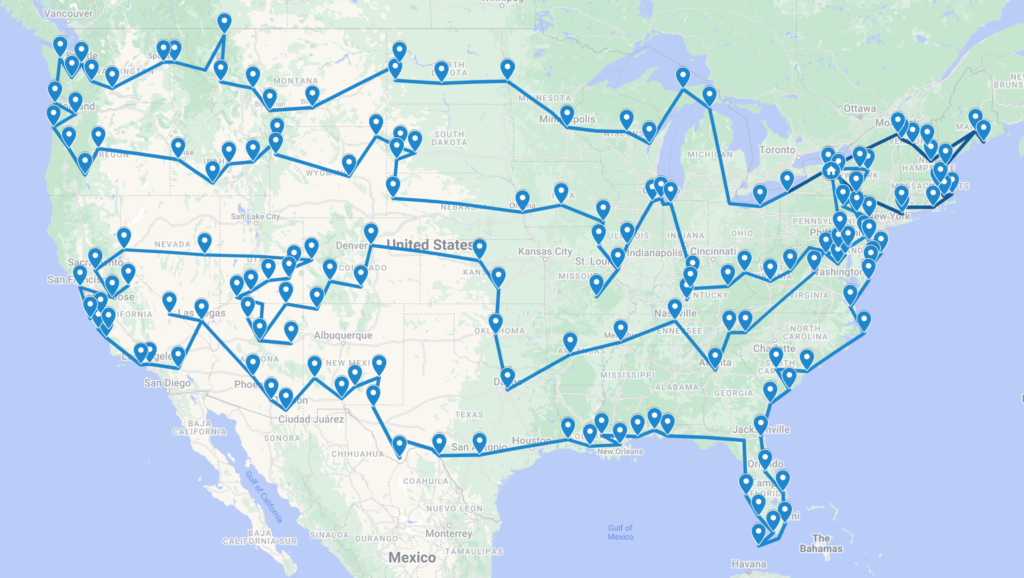By Shelby

Casper was a pretty neat city. It’s located in the middle of a desert and is known for its oil production. We got the cheapest gas here we’ve gotten in a long time – about $3.30. That was a nice break from the $5 per gallon prices we’ve been paying. On Monday, we worked from the library in the city. I’ve decided to look into travel consulting for work. Many companies provide travel planning services and I think this is something I would enjoy. After work, we went to a nearby park and made pasta and broccoli for dinner.

Tuesday we worked from the same library. After lunch, we got started on our long drive to Rapid City, South Dakota. I drove while Spencer worked. Once we left Casper, we were driving through yellow and brown deserts for hours. As we continued north, we made a detour to Devils Tower National Monument, an oddly shaped rock formation. Devils Tower was made famous by being featured in the movie Close Encounters of the Third Kind.

As we got closer to the monument, we noticed an increasing number of motorcycles. It turns out we had driven right into the Sturgis Motorcycle Rally, the largest motorcycle rally in the world. There were motorcycles everywhere! When we got to the monument, we did a mile walk on a trail around it. A few people told us they saw some deer ahead of us on the trail, but we only saw a couple wild turkeys off in the woods. They were surprisingly large for wild turkeys.

After we finished our walk, we drove onto a scenic byway through the Black Hills. It was very nice. We even saw a couple white mountain goats next to the road. Past the scenic byway, we stopped at the largest gold mine in the western hemisphere. The visitors center and free museum were unfortunately closed by now, so we weren’t able to go there.

We drove on to Deadwood, a preserved old western mining town. Our plan was to stop at an old saloon with a museum where a guy was famously shot while playing poker, but the whole town was flooded with people from the motorcycle rally. The entire main street was lined with motorcycles on both sides. Since it was so crowded, we decided to move right on to Rapid City, where we would be staying for the next few days. Rapid City was also located in a desert plains area. It was a little more green than Casper. Unfortunately the Planet Fitness we slept at was pretty close to I-90, so it was very loud at night.

Wednesday, we worked from a library for 2 hours since they only had 2 hour parking. After that, we drove up a hill in the middle of the city to Dinosaur Park, a park that had dinosaur statues. We found a nice overlook over the city and worked from the car for the rest of the day. The temperature was very hot, so we used the car’s AC to stay cool. We’ve been worried about leaving the car sitting in a hot parking lot all day with a propane tank in the back. And running the AC or just finding shade and opening the windows keeps the interior cooler. Fortunately, our unlimited mobile data plans allow us to work from the car as long as we have good cell coverage.

After work, we drove half an hour to Mt. Rushmore. When we got there, we were surprised to find out we had to pay for parking. Our park pass wouldn’t work here even though it was a national memorial. It was very crowded on the main walkway. The walkway was pretty neat. It was lined with flags from each state. The whole area was very developed. There were a couple of food trucks, a gift shop, an ice cream shop, and a whole amphitheater.

We walked a mile-long loop trail that brought us closer to the mountain. It was neat learning about how Mt. Rushmore was created. They used dynamite to blast away the outer surface rock that was too hard for carving, then used drills and jackhammers to create the general features, and finished with hand bumpers to smooth out the surface. About 400 men worked on carving the mountain and no one died. When we made it back to the main area, we decided to stay until 9 pm for the lighting ceremony.

We are very glad we stayed for the ceremony. A ranger gave a talk about the history of Mt. Rushmore and played a video that went into even more depth. At the end of the video, the lights turned on that lit up Mt. Rushmore. It was very cool and patriotic. We learned some interesting facts about the four featured presidents. After the ceremony ended, we made our way back to Rapid City.

Thursday morning, we got up early and drove a little over an hour to Badlands National Park. Along the way, we stopped at the Minuteman Missile National Historic Site visitors center. This is where an old decommissioned nuclear missile silo from the Cold War was located. Unfortunately, the actual silo wasn’t open yet, so we would have to stop there on the way back to Rapid City.

When we arrived at Badlands National Park, it was already almost 90 degrees out. It was only going to get hotter, so we decided to get the hikes out of the way first. The first few hikes were very short, less than a mile each. These trails were boardwalks that brought us right into the badlands. This park allowed people to walk wherever they wanted, so we walked off the boardwalk to look into a small canyon. This park reminded us of Theodore Roosevelt National Park, except it was dryer and a lot more desert-y.

The badlands were very interesting. The whole area was under a sea 80 million years ago. After the sea dried up, the land left behind would eventually become the badlands. The structures were formed by rivers carving out canyons and now they are eroded by the wind and rain. They easily crumbled if touched.

After the short hikes, we had a longer 3-mile hike planned. This hike was more wild and didn’t have a boardwalk. We walked directly on the badlands. We climbed a ladder up one of the hills to walk on a ridge. The trail was very interesting and very hot. There was very little shade. At the end of the trail, there was an overlook over the park. We went off the trail and climbed up to a different area where we got a much better view without roads or buildings. After taking plenty of pictures, we headed back to the car. It was very hot out now, in the high 90s. The sun was brutal.

We stopped at the visitors center to fill up our water bottles before driving to a scenic parking spot to eat lunch. It was too hot to leave the windows open, so we ate in the car with the AC on. We were glad we hiked earlier before it was this hot. We saw a couple people starting off on a longer hike while we ate. We thought they were crazy for hiking in this heat.

After lunch, we continued driving through the park and stopped at a few more overlooks. Further in the park, the hills became more colorful and there were wild sunflowers that were very pretty. We didn’t see too many animals. There were some chipmunks and birds, but not much else.

When we finished with the park, we returned to the missile silo, which was now open. It was really in the middle of nowhere. We got a kick out of the restricted access sign on the fence surrounding the silo since we were allowed in. The silo was covered with a glass window, so we could look down at the fake missile in it. It was pretty neat.

We then returned to Rapid City and went grocery shopping. We didn’t feel like cooking since it was so hot out, so we got cereal to have for dinner. After that, we returned to the hill in the middle of the city to see the sunset. The sunset was very pretty. That evening we watched National Treasure 2, inspired by our trip to Mt. Rushmore the day before.

The next morning, we got up early again to start our drive to Wind Cave National Park. Along the way, we drove through Custer State Park. We were very impressed with what we saw. There was a lot of wildlife including bison, prairie dogs, and even a big horn sheep that crossed the road in front of us. We didn’t realize so many of these animals lived outside of national parks.

When we entered the park, there was a large herd of bison on the side of the road. We stopped to take a few pictures. A few of them crossed the road in front of us. Our first hike of the day was up Rankin Ridge through the ponderosa pines of the Black Hills. We followed along a self-guided tour through the national park service app as we went. We learned a lot about the natural cycle of forest lands and the important role of forest fires. The trail was very nice and there were very few people. From the top, we had a nice view of the forests and prairies below.

Our original plan was to then do a 5 mile hike, but it was really hot and we were satisfied by our shorter hike up Rankin Ridge. We decided to skip the longer hike and go right to the visitors center. We bought tickets to do the Natural Cave tour in Wind Cave. This tour led us down 300 stairs deep into the cave. It was around 50 degrees in the cave compared to 90 at ground level. It felt really nice.

The trail in the cave was paved and lit up by lamps on the wall. The tour guide pointed out different features of the cave. The cave was formed when the sea that used to cover the area dried up. At one point, the tour guide turned off all the lights and lit a candle to simulate what it used to be like to explore the cave. That was very cool. It was pitch black besides the candle.

At the bottom of the cave, far below where tours go, are a series of lakes that form the Madison Aquifer, which is used for drinking water for multiple states. We would have liked to be able to see the lakes, but it takes at least 4 hours to get there and only researchers are allowed down there.

At the end of the cave tour, we took an elevator back to ground level. We were pretty hungry by now, so we drove to a pullout down the road near a small herd of bison. As we ate, they got closer and closer until they surrounded the car. Slowly they moved on past us. The prairie dogs popping out of the ground watched them intently.

When we finished lunch, we moved on south through South Dakota into Nebraska. There was a whole lot of nothing along the drive. There were endless deserts and plains. A couple hours later, we reached the city of Scottsbluff. This was a major landmark in the original Oregon Trail. The pioneers were a third of the way to the end.

Since we still had some free time, we went to Scotts Bluff National Monument to hike a 4 mile trail to the top of the bluff. The trail was paved the whole way and had beautiful views of the rock structures in the area. Near the top, there was a tunnel we walked through to get to the other side of the bluff. On that side, we had a view of the city below. We reached the top shortly after the sun set. We took a few quick pictures before heading down the road this time. The park technically closed at sunset, but we still saw people coming up so we weren’t too worried.

By the time we made it back to the car, it was dark out. On the drive to Walmart, where we were sleeping that night, we saw the super moon. It looked pretty big and orange. Unfortunately, a storm was blowing in, so we wouldn’t be able to see the meteor shower that night. The storm woke us up in the middle of the night when I got dripped on by water coming in through the cracked window. The wind was very strong. We shut the windows until the storm slowed.

The next morning, we returned to Scotts Bluff to walk a mile-long trail that follows the original Oregon Trail. There were even replica wagons that showed what the pioneers used. At the end of the trail, we saw many hot air balloons in the air. It turns out there was a hot air balloon festival going on. Scotts Bluff was also home to a Pony Express station. The Pony Express was a mail system between Missouri and California that was able to transport mail between the two terminals in 10 days until a national telegraph system was developed.

When we returned to the car, we set out on a 7-hour drive east to Omaha, following a similar path of early settlers migrating west. It probably would have taken them days to cover the same distance. It’s amazing we can now make the trip across the state traveling 80 miles per hour on paved roads with air conditioning. While on the road we passed Chimney Rock, another famous landmark from the Oregon Trail.

Once we left Scotts Bluff, Nebraska was very flat and had lots of farms. I couldn’t believe how many cornfields there were. We also saw tons of truckers on Interstate 80, it must be a major shipping route. Once we made it to Omaha, we went to a park to relax and work on the website. None of the Planet Fitnesses in Omaha were open 24 hours Saturday night so we spent the night at a Cracker Barrel for the first time on the trip. It was a nice and quiet night. Our plan for Sunday is to mostly relax and finish up the website. We’ll be in Omaha for a few days most likely, but we don’t have a set plan yet. Check out our state pages for South Dakota and Nebraska for more pictures.
Fun Facts from Week 16:
- Devils Tower in Wyoming is the first national monument.
- The CCC paved the trails in Wind Cave with asphalt in the 1930s by carrying it into the cave in sealed car tires around their necks.
- It is estimated that only 10% of Wind Cave in Wind Cave National Park has been explored so far.
- Between 1841 and 1869, over 250,000 emigrants traveled through the Scotts Bluff area. It marked completion of the first 1/3rd of the trail. About 1/10th of emigrants did not survive the entire journey west.
- Chimney rock was an important landmark for settlers traveling along the Oregon, California and Mormon Trails. Many migrants noted in their journals relief upon seeing the rock and thousands carved their names into the tower.





One response to “Week 16”
Shelby great idea about travel industry job .Always wonder if that is the field you should be in with all the planning and love of traveling you have done.